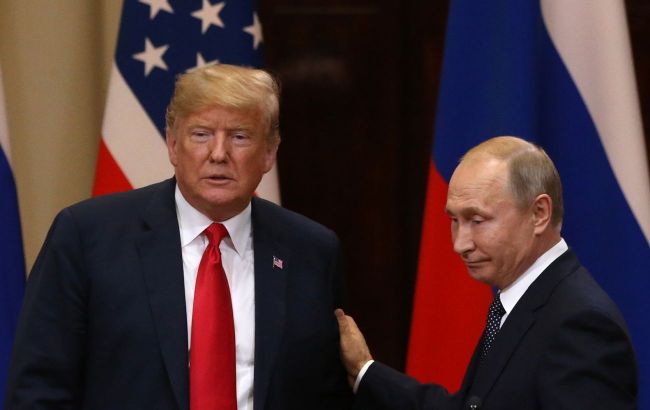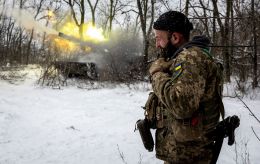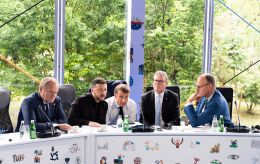Trump-Putin Alaska meeting: Will Ukraine's fate be sealed?
 Photo: Donald Trump and Vladimir Putin will meet in Alaska (Getty Images)
Photo: Donald Trump and Vladimir Putin will meet in Alaska (Getty Images)
Next week, US President Donald Trump and Vladimir Putin will hold a historic meeting that could mark the start of ending the war in Ukraine — but the terms of future peace raise many questions.
RBC-Ukraine has compiled everything known about the upcoming summit.
Key questions:
- Trump and Putin will meet on August 15 in Alaska
- Alaska is ready, but the exact time and venue are still unknown
- Zelenskyy is not invited; the summit will be bilateral
- Trump proposes a territorial exchange in Ukraine; Putin demands all occupied territories
- Ukraine and Europe have sent Trump their counterproposal for Putin’s conditions
When will the Alaska summit take place?
The mystery around the date and location of the meeting between the US and Russian leaders unfolded over several days and was settled by a single post on Truth Social.
"The highly anticipated meeting between myself, as President of the United States of America, and President Vladimir Putin, of Russia, will take place next Friday, August 15, 2025, in the Great State of Alaska," - Trump wrote.
Putin confirmed the agreement. According to his aide Yuri Ushakov, Russia and the US are "close neighbors," so it makes sense that the Russian delegation can simply fly over the Bering Strait to meet Trump.
Another publicly stated reason is that Alaska and the Arctic are areas where both countries' interests intersect, with "prospects for large-scale projects." It seems Russia is playing on Trump's business ambitions.
Ushakov also said the leaders will discuss how to achieve long-term peace for Ukraine and Russia. He added that Moscow and Washington will spend the coming days working out the details of the Alaska summit.
It remains unclear whether the meeting will take place in Juneau (the state capital), Anchorage (the largest city), or another location. Governor Mike Dunleavy emphasized that Alaska is ready.
The choice is rather unexpected. Earlier, Western media sources suggested the White House was considering Italy, Switzerland, or Hungary, while Putin had named the United Arab Emirates as a suitable location.
Security concerns may have played a role, as the US is not subject to the jurisdiction of the International Criminal Court, which has issued an arrest warrant for Putin. But the historical context likely played a key role as well.
The Russian Empire was the first colonial power to settle Alaska. The territory belonged to Russia from the late 18th century until 1867, when the US bought it for just $7.2 million — equivalent today to between $150 million and over $1 billion, depending on inflation or gold value. A century later, oil was discovered there, and Alaska is now among the top five US states in oil production.
Putin will be the first Russian leader in history to personally visit Alaska. Western analysts say he will try to push a territorial deal favorable to him regarding Ukraine.
Will Zelenskyy attend the meeting, and what was his response to Trump?
According to CBS News, the format of the meeting has not yet been finalized. Moreover, a White House source reported that it is still possible that Ukrainian President Volodymyr Zelenskyy "may participate" in the Alaska summit in some capacity.
The president himself has said nothing about this in the past two days. However, media outlets report that the Trump administration is considering inviting him and "everyone hopes that it will happen."
In response to the news about the summit, Zelenskyy made it clear that he is at least somewhat dissatisfied. According to him, the Alaska meeting is far removed from the war, which cannot be ended without Ukraine.
"Putin did not believe in our people, so he made this hopeless decision to try to take Ukraine. That was his main mistake — ignoring the Ukrainians. I believe in our people because Ukrainians are strong, because Ukrainians defend their land," he said.
Earlier, Trump stated that for the sake of peace, Zelenskyy would have to "sign something." According to him, a territorial swap is being prepared, supposedly in the interests of both sides. But the "swap" with Russia would concern only Ukrainian territories.
Zelenskyy responded that all partners must understand what a dignified peace means — and that Russia must end the war.
"The answer to Ukraine's territorial question is already in the Constitution of Ukraine. No one will and cannot back down from this. Ukrainians will not give their land to the occupiers," the president said, adding that any decisions made without Ukraine will be "dead."
What territorial exchange will Trump and Putin discuss?
Apparently, alongside the ceasefire, the central issue at the Alaska summit will be Ukrainian lands. Although there are no official statements about which territories might be involved in the "swap," leaks in Western media provide some insight.
As The Wall Street Journal reports, Putin told US special envoy Steve Witkoff a new condition for a ceasefire — complete withdrawal of Ukrainian troops from Donetsk region. According to WSJ sources, he is already backing away from earlier demands. A year ago, the dictator demanded withdrawal from Kherson and Zaporizhzhia regions as well, just to begin peace talks.
The proposal supposedly includes two stages:
- Withdrawal of the Defense Forces from Donetsk region and freezing the front line
- Agreement on the final peace plan with Trump and Zelenskyy
Essentially, Moscow is trying to push through the annexation of the entire Donbas, as well as the recognition of it and Crimea as "sovereign Russian territory." At the same time, it’s unclear whether Russia is ready to withdraw from the occupied South. According to an unnamed Ukrainian official cited by the Wall Street Journal, Kyiv generally does not reject any proposals but demands a ceasefire as a prerequisite for any further steps.
Overall, this information aligns with data from other media outlets. According to Bloomberg, the US is trying to secure the support of Ukraine and European partners and, apparently, to get the "green light" for de facto territorial concessions.
Under the agreement, Russia would supposedly stop hostilities in Kherson and Zaporizhzhia regions. However, it remains unclear whether Russia is ready to put control over the Zaporizhzhia nuclear power plant or other territories "on the table." The publication emphasizes that the main goal now is to freeze the conflict and create conditions for real negotiations to begin.
Recently, the Polish portal Onet published what is said to be the plan Witkoff took to Putin, which contains points favorable to Moscow as well as those it had previously categorically rejected:
- Ceasefire in the Russia-Ukraine war
- Recognition of the occupied territories as Russian
- Discussion of their status in the future after 49 or 99 years
- Lifting most sanctions and resuming imports of Russian gas and oil
- The West does not guarantee NATO will not expand
- The West does not guarantee an end to military support for Ukraine
German BILD reports that, in fact, Putin has not abandoned plans for the Kherson and Zaporizhzhia regions, and Witkoff may have misunderstood him. WSJ sources clarify that Trump initially told European leaders that Putin was ready to withdraw from the southern regions, but the special envoy later denied this.
What Ukraine and Europe say about territorial exchange
Amid news of the Alaska summit, Ukraine has intensified contacts with its partners. The president has been in talks with European leaders to coordinate a unified position and communicate it to Trump. He also spent the entire previous day on the phone.
From his statements, it is clear that there will be no territorial concessions, at least none legally formalized. Here are several key declarations:
"Russia is pushing for an exchange of Ukrainian territory without guarantees that the war won’t resume in the future."
"It is important that Russia does not succeed in deceiving anyone again."
"Trump wants to stop the killings, but Russia’s plan must be met with wise and coordinated action."
"Putin was allowed to take Crimea. He wants forgiveness for seizing the South and East, but there will be no second attempt to divide Ukraine."
Yesterday, a crucial meeting of national security advisers took place in London. It seems that Secretary of the National Security and Defense Council Rustem Umerov and Head of the Office of the President Andriy Yermak, along with partners, successfully conveyed the necessary signals to Washington, represented by Vice President J.D. Vance.
According to The Wall Street Journal, they presented a counterproposal. The main message is that the idea of a ceasefire in exchange for withdrawal from Donetsk region is unlikely to succeed. Territorial exchanges can only happen on a mutual basis: if Ukraine withdraws troops, Russia must return something in exchange.
President Zelenskyy assured that Trump heard these arguments and acknowledged the danger of Russia's plan. Axios, citing sources, reported serious progress toward resolving the war.
On Sunday night, European leaders issued a joint statement on peace for Ukraine, effectively demanding that Trump ensure at Alaska:
- reliable security guarantees for Ukraine
- freedom to choose its own destiny
- a ceasefire before real peace talks begin
- the current front line as the starting point for negotiations
Sources: statements by US President Donald Trump, Ukrainian President Volodymyr Zelenskyy, other officials, and publications from Onet, Bloomberg, Axios, BILD, and The Wall Street Journal.

